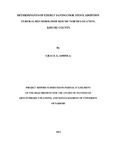| dc.description.abstract | Many of rural households use traditional stoves which have low energy efficiency leading to using more wood fuel, increase in indoor air pollution and also putting a lot of pressure on biomass sources. There have been efforts to promote use of wood fuel technologies; this program has been spearheaded by the Ministry of Agriculture and Nongovernmental Organizations. There are technologies in Kenya that can reduce the consumption of biomass energy by 80%. They include the improved charcoal stove (KCJ)which can save
xi
up to 50% and the improved fuel wood stoves eg”Kuni Mbili” which can save up to 50% but the adoption rate has remained low. The study was carried out to assess the factors determining the adoption of the improved energy saving cook stoves, asses the level at which the economic status of the household influences the adoption of the improved energy saving stoves, examine how cultural beliefs and practices influence the adoption of improved energy saving cooking stoves and investigate the level at which sensitization of the rural households influence the adoption of improved cook stoves in Kisumu North Location, Kisumu County. Descriptive survey research design was used to collect the required data. The target population included 896 households where Multi stage sampling was used to select 390 households .The study used questionnaires for primary data collection. Qualitative data was analyzed through interviews .The validity of the research results were determined through content and face validity while reliability was done by piloting a section of the sample and carrying out the test retest. The research results were considered reliable since a correlation coefficient of above 0.7 was achieved. Quantitative data was analyzed using descriptive and inferential statistics. Data collected through the open ended questions and analysis of documents was done qualitatively through content analysis and presented in themes. The study established that family size of 4-5 members had adopted the energy saving cook stove 55 (14.1%) strongly agreeing that it saved a lot of fuel, family of 1-3 with 51 (13.1%) and 6-10 members with 27 (6.9%) and those families with more than 10 members with 1 (0.3%) strongly agreeing that it saved fuel. Age was also found to have influence on adoption as middle aged group ranging from 26-45 years were the ones who had embraced the energy saving technology with a frequency of 127, those with56 years and above had frequency of 80, 36-45 had 77,46-55 had 55 while those aged 15-25 had 51 frequencies respectively. Further results on gender and time revealed that the women had embraced the energy saving technology more than the men since most of them were in charge of cooking and were the mostly the decision makers on matters pertaining to cooking in the households. Conclusions and recommendations were drawn from the results based on research objectives. The findings indicate that among the factors influencing the adoption of energy saving cook stoves, information dissemination was the most influential factor, followed by decision dynamics. Economic status of the household head did not have much influence since adoption was observed despite the low economic status. Thus information dissemination needs to be enhanced fully to ensure maximum adoption. | en_US |

